Abstract
Recently, many investigators have studied the effects of eicosapentaenoic acid (EPA)-rich fish oil on immune function and immune disease. However, effects of dietary supplementation of fish oil or EPA on the immune system are still unclear. In the present study, the effects of EPA on antigen presentation were investigated. We have used antigen-specific helper T-cell clones that proliferate in the presence of antigen [keyhole limpet haemocyanin (KLH)] and spleen cells as antigen-presenting cells (APC). Mice were divided into two groups and fed an experimental diet or a control diet for 4 weeks ad libitum. In mice fed the experimental diet, the arachidonic acid (AA) content of spleen cells was decreased and that of EPA and docosapentaenoic acid was increased markedly compared to those of the control diet. Dietary enrichment with EPA inhibited the ability of accessory cells to present antigen to murine helper T-cell clones. This effect was observed for two distinct helper T-cell clones, Th1 and Th2. We also examined the effects of EPA-TG emulsion on APC function. The direct addition of EPA-TG emulsion to a T-cell proliferation assay system suppressed APC function. The inhibition was proportional to the concentration of EPA-TG emulsion. Pretreatment of splenocytes with EPA-TG emulsion resulted in inhibition of APC function. Inhibition of antigen presentation by dietary supplementation with EPA might depress immune reactivity.
Full text
PDF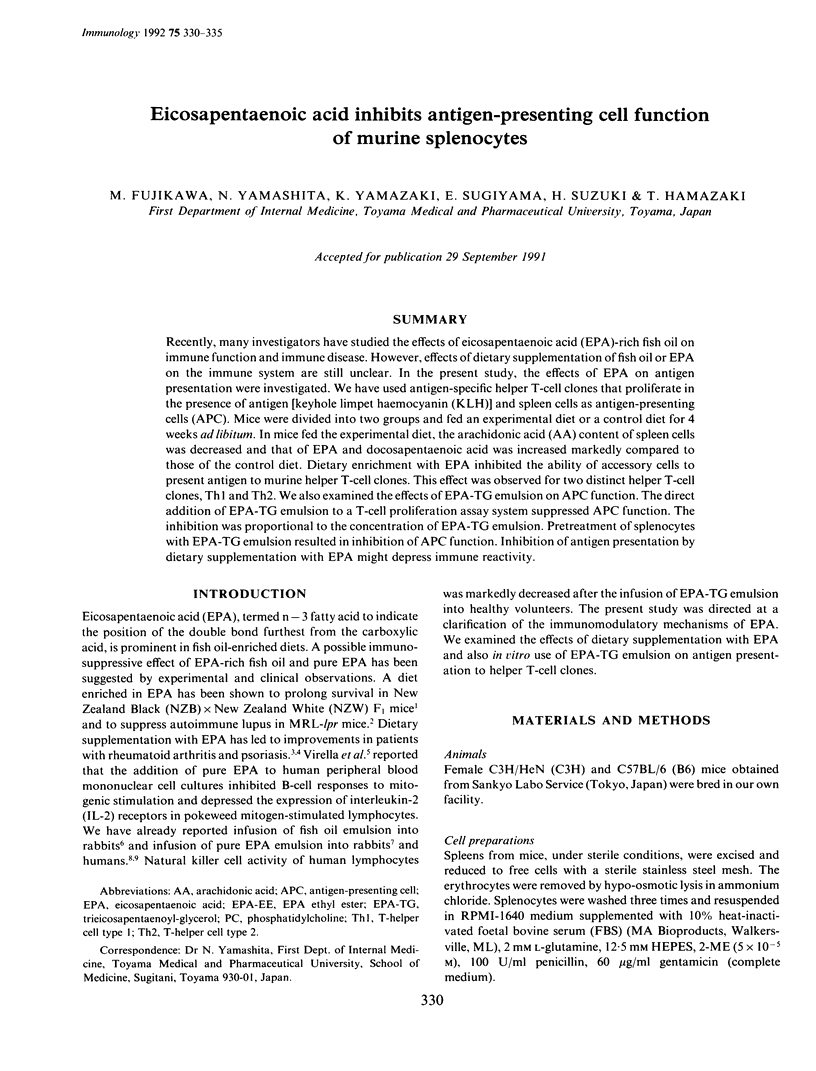
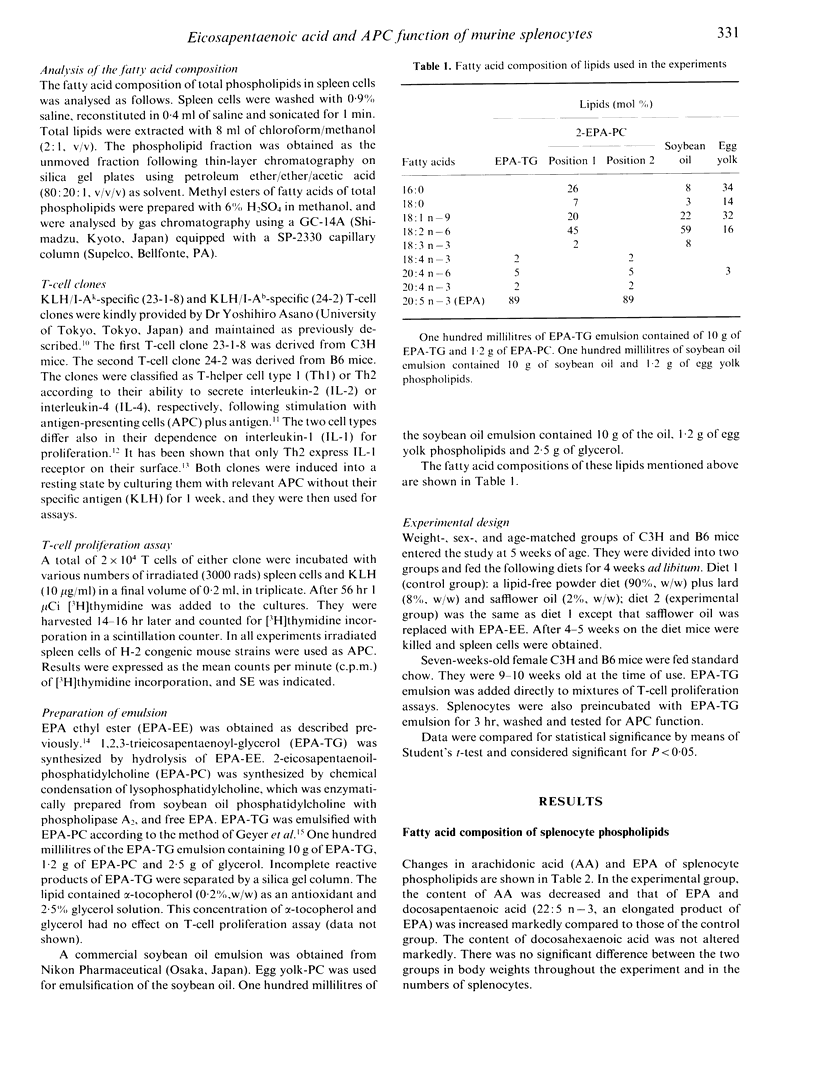
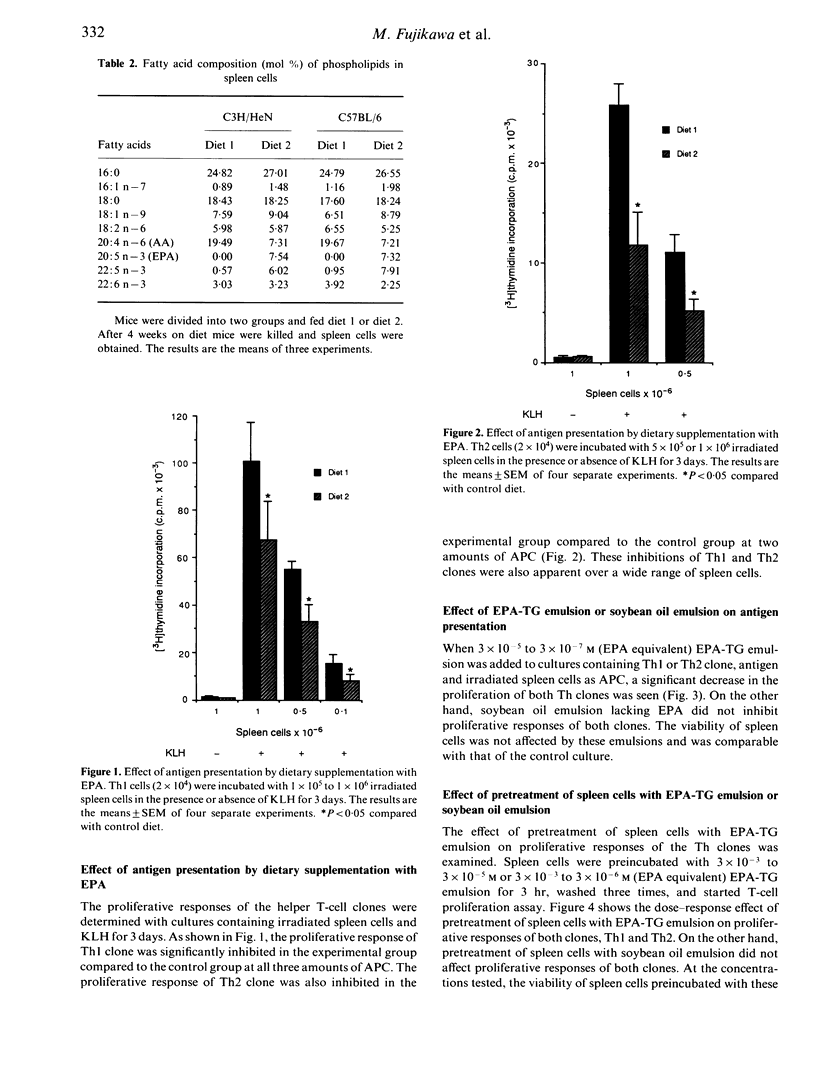
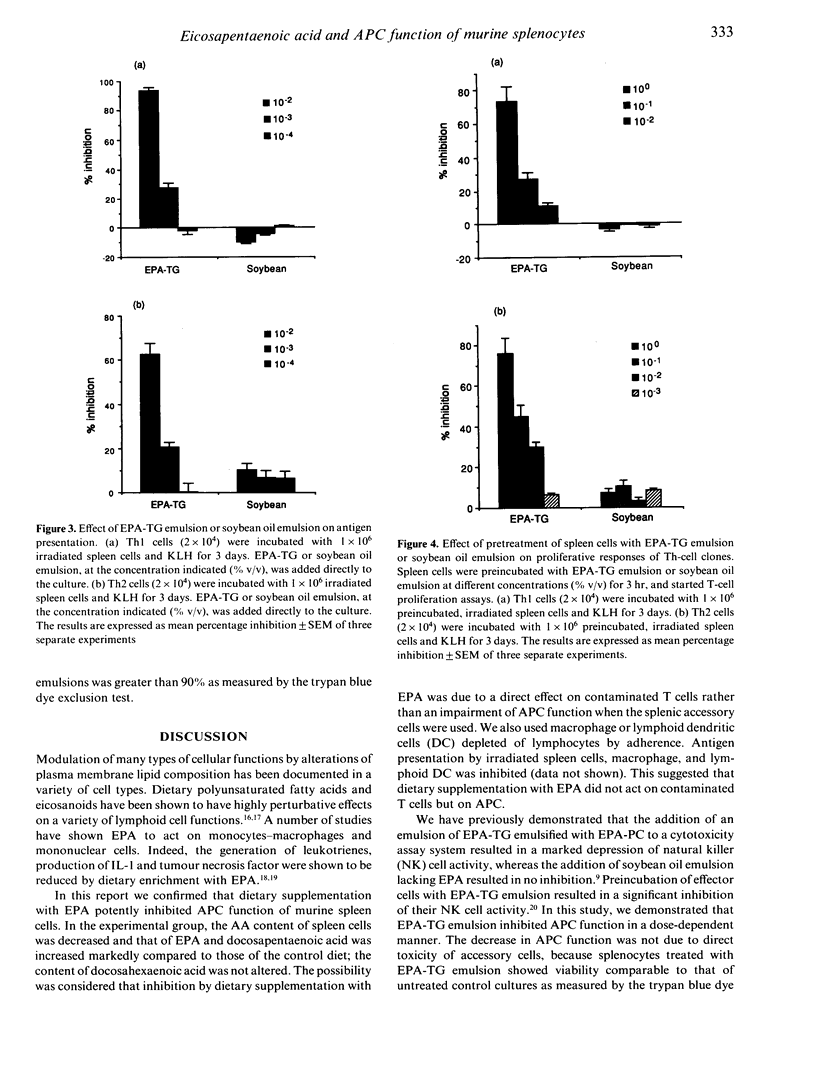
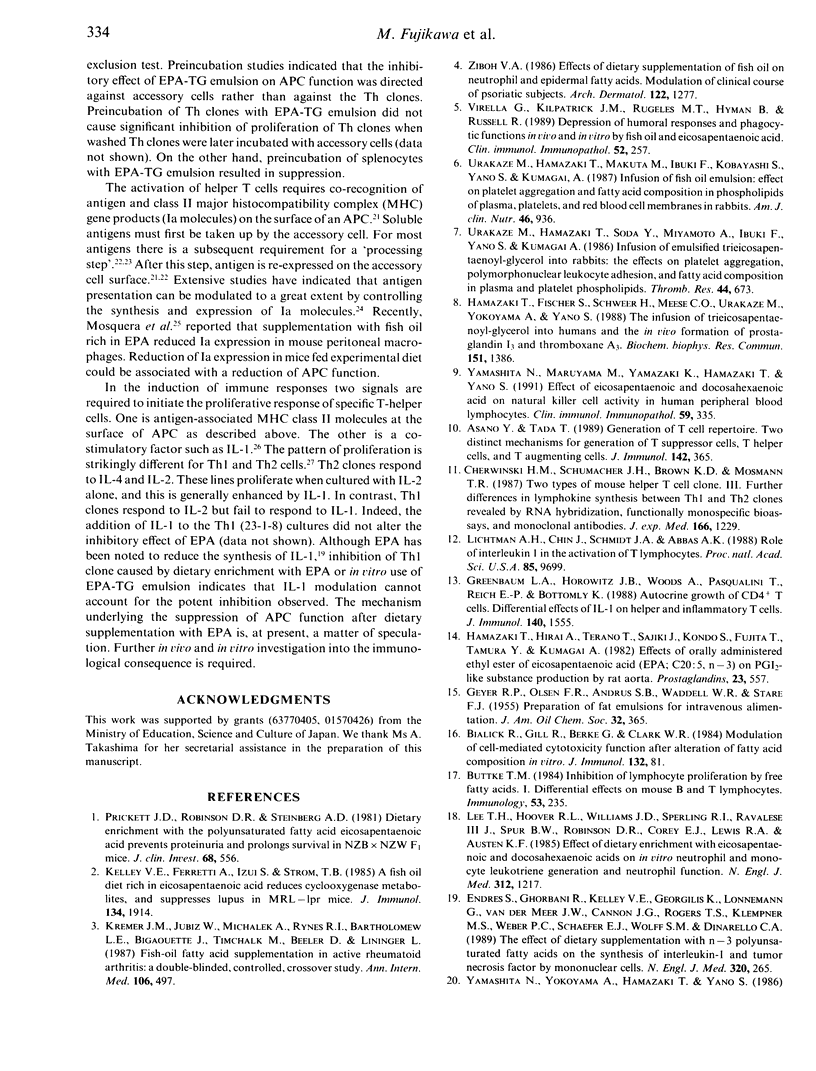
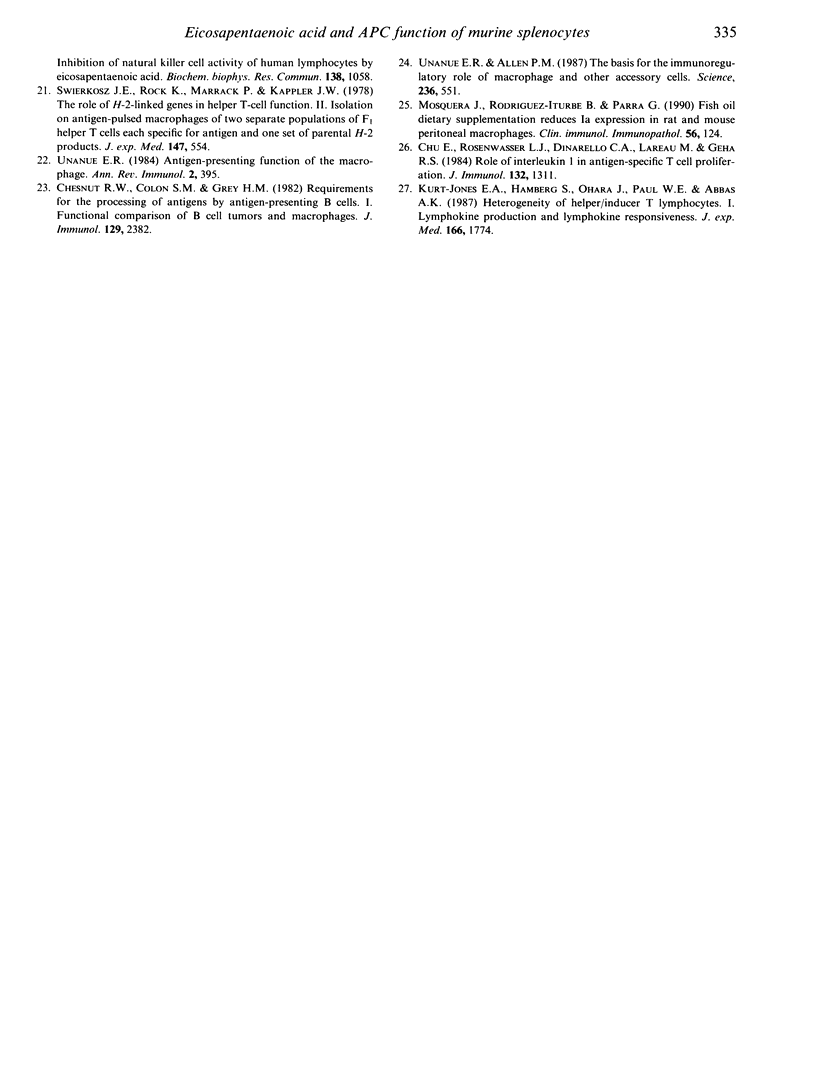
Selected References
These references are in PubMed. This may not be the complete list of references from this article.
- Asano Y., Tada T. Generation of T cell repertoire. Two distinct mechanisms for generation of T suppressor cells, T helper cells, and T augmenting cells. J Immunol. 1989 Jan 15;142(2):365–373. [PubMed] [Google Scholar]
- Bialick R., Gill R., Berke G., Clark W. R. Modulation of cell-mediated cytotoxicity function after alteration of fatty acid composition in vitro. J Immunol. 1984 Jan;132(1):81–87. [PubMed] [Google Scholar]
- Buttke T. M. Inhibition of lymphocyte proliferation by free fatty acids. I. Differential effects on mouse B and T lymphocytes. Immunology. 1984 Oct;53(2):235–242. [PMC free article] [PubMed] [Google Scholar]
- Cherwinski H. M., Schumacher J. H., Brown K. D., Mosmann T. R. Two types of mouse helper T cell clone. III. Further differences in lymphokine synthesis between Th1 and Th2 clones revealed by RNA hybridization, functionally monospecific bioassays, and monoclonal antibodies. J Exp Med. 1987 Nov 1;166(5):1229–1244. doi: 10.1084/jem.166.5.1229. [DOI] [PMC free article] [PubMed] [Google Scholar]
- Chesnut R. W., Colon S. M., Grey H. M. Requirements for the processing of antigens by antigen-presenting B cells. I. Functional comparison of B cell tumors and macrophages. J Immunol. 1982 Dec;129(6):2382–2388. [PubMed] [Google Scholar]
- Chu E., Rosenwasser L. J., Dinarello C. A., Lareau M., Geha R. S. Role of interleukin 1 in antigen-specific T cell proliferation. J Immunol. 1984 Mar;132(3):1311–1316. [PubMed] [Google Scholar]
- Endres S., Ghorbani R., Kelley V. E., Georgilis K., Lonnemann G., van der Meer J. W., Cannon J. G., Rogers T. S., Klempner M. S., Weber P. C. The effect of dietary supplementation with n-3 polyunsaturated fatty acids on the synthesis of interleukin-1 and tumor necrosis factor by mononuclear cells. N Engl J Med. 1989 Feb 2;320(5):265–271. doi: 10.1056/NEJM198902023200501. [DOI] [PubMed] [Google Scholar]
- Greenbaum L. A., Horowitz J. B., Woods A., Pasqualini T., Reich E. P., Bottomly K. Autocrine growth of CD4+ T cells. Differential effects of IL-1 on helper and inflammatory T cells. J Immunol. 1988 Mar 1;140(5):1555–1560. [PubMed] [Google Scholar]
- Hamazaki T., Fischer S., Schweer H., Meese C. O., Urakaze M., Yokoyama A., Yano S. The infusion of trieicosapentaenoyl-glycerol into humans and the in vivo formation of prostaglandin I3 and thromboxane A3. Biochem Biophys Res Commun. 1988 Mar 30;151(3):1386–1394. doi: 10.1016/s0006-291x(88)80516-3. [DOI] [PubMed] [Google Scholar]
- Hamazaki T., Hirai A., Terano T., Sajiki J., Kondo S., Fujita T., Tamura Y., Kumagai A. Effects of orally administered ethyl ester of eicosapentaenoic acid (EPA; C20:5, omega-3) on PGI2-like substance production by rat aorta. Prostaglandins. 1982 Apr;23(4):557–567. doi: 10.1016/0090-6980(82)90116-2. [DOI] [PubMed] [Google Scholar]
- Kelley V. E., Ferretti A., Izui S., Strom T. B. A fish oil diet rich in eicosapentaenoic acid reduces cyclooxygenase metabolites, and suppresses lupus in MRL-lpr mice. J Immunol. 1985 Mar;134(3):1914–1919. [PubMed] [Google Scholar]
- Kremer J. M., Jubiz W., Michalek A., Rynes R. I., Bartholomew L. E., Bigaouette J., Timchalk M., Beeler D., Lininger L. Fish-oil fatty acid supplementation in active rheumatoid arthritis. A double-blinded, controlled, crossover study. Ann Intern Med. 1987 Apr;106(4):497–503. doi: 10.7326/0003-4819-106-4-497. [DOI] [PubMed] [Google Scholar]
- Kurt-Jones E. A., Hamberg S., Ohara J., Paul W. E., Abbas A. K. Heterogeneity of helper/inducer T lymphocytes. I. Lymphokine production and lymphokine responsiveness. J Exp Med. 1987 Dec 1;166(6):1774–1787. doi: 10.1084/jem.166.6.1774. [DOI] [PMC free article] [PubMed] [Google Scholar]
- Lee T. H., Hoover R. L., Williams J. D., Sperling R. I., Ravalese J., 3rd, Spur B. W., Robinson D. R., Corey E. J., Lewis R. A., Austen K. F. Effect of dietary enrichment with eicosapentaenoic and docosahexaenoic acids on in vitro neutrophil and monocyte leukotriene generation and neutrophil function. N Engl J Med. 1985 May 9;312(19):1217–1224. doi: 10.1056/NEJM198505093121903. [DOI] [PubMed] [Google Scholar]
- Lichtman A. H., Chin J., Schmidt J. A., Abbas A. K. Role of interleukin 1 in the activation of T lymphocytes. Proc Natl Acad Sci U S A. 1988 Dec;85(24):9699–9703. doi: 10.1073/pnas.85.24.9699. [DOI] [PMC free article] [PubMed] [Google Scholar]
- Mosquera J., Rodríguez-Iturbe B., Parra G. Fish oil dietary supplementation reduces Ia expression in rat and mouse peritoneal macrophages. Clin Immunol Immunopathol. 1990 Jul;56(1):124–129. doi: 10.1016/0090-1229(90)90176-q. [DOI] [PubMed] [Google Scholar]
- Prickett J. D., Robinson D. R., Steinberg A. D. Dietary enrichment with the polyunsaturated fatty acid eicosapentaenoic acid prevents proteinuria and prolongs survival in NZB x NZW F1 mice. J Clin Invest. 1981 Aug;68(2):556–559. doi: 10.1172/JCI110288. [DOI] [PMC free article] [PubMed] [Google Scholar]
- Swierkosz J. E., Rock K., Marrack P., Kappler J. W. The role of H-2 linked genes in helper T-cell function. II. Isolation on antigen-pulsed macrophages of two separate populations of F1 helper T cells each specific for antigen and one set of parental H-2 products. J Exp Med. 1978 Feb 1;147(2):554–570. doi: 10.1084/jem.147.2.554. [DOI] [PMC free article] [PubMed] [Google Scholar]
- Unanue E. R., Allen P. M. The basis for the immunoregulatory role of macrophages and other accessory cells. Science. 1987 May 1;236(4801):551–557. doi: 10.1126/science.2437650. [DOI] [PubMed] [Google Scholar]
- Unanue E. R. Antigen-presenting function of the macrophage. Annu Rev Immunol. 1984;2:395–428. doi: 10.1146/annurev.iy.02.040184.002143. [DOI] [PubMed] [Google Scholar]
- Urakaze M., Hamazaki T., Makuta M., Ibuki F., Kobayashi S., Yano S., Kumagai A. Infusion of fish oil emulsion: effects on platelet aggregation and fatty acid composition in phospholipids of plasma, platelets, and red blood cell membranes in rabbits. Am J Clin Nutr. 1987 Dec;46(6):936–940. doi: 10.1093/ajcn/46.6.936. [DOI] [PubMed] [Google Scholar]
- Urakaze M., Hamazaki T., Soda Y., Miyamoto A., Ibuki F., Yano S., Kumagai A. Infusion of emulsified trieicosapentaenoyl-glycerol into rabbits--the effects on platelet aggregation, polymorphonuclear leukocyte adhesion, and fatty acid composition in plasma and platelet phospholipids. Thromb Res. 1986 Dec 1;44(5):673–682. doi: 10.1016/0049-3848(86)90168-4. [DOI] [PubMed] [Google Scholar]
- Yamashita N., Maruyama M., Yamazaki K., Hamazaki T., Yano S. Effect of eicosapentaenoic and docosahexaenoic acid on natural killer cell activity in human peripheral blood lymphocytes. Clin Immunol Immunopathol. 1991 Jun;59(3):335–345. doi: 10.1016/0090-1229(91)90029-a. [DOI] [PubMed] [Google Scholar]
- Yamashita N., Yokoyama A., Hamazaki T., Yano S. Inhibition of natural killer cell activity of human lymphocytes by eicosapentaenoic acid. Biochem Biophys Res Commun. 1986 Aug 14;138(3):1058–1067. doi: 10.1016/s0006-291x(86)80389-8. [DOI] [PubMed] [Google Scholar]


